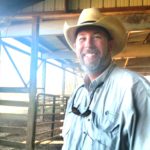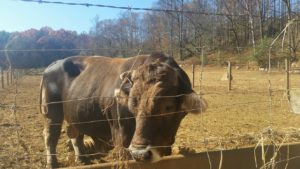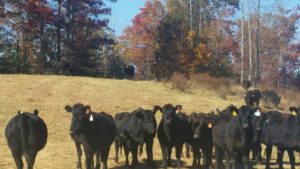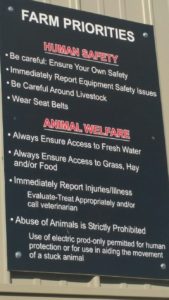 When you visit a cattle ranch, even if it’s in North Carolina, you need to plan to wear boots. The short, cute leather boots I was wearing when I visited Ridgefield Farm in Brasstown, North Carolina were probably not the best choice. To make matters worse, the unseasonably warm fall weather compounded by the drought made it very dry and dusty…these boots may never be the same.
When you visit a cattle ranch, even if it’s in North Carolina, you need to plan to wear boots. The short, cute leather boots I was wearing when I visited Ridgefield Farm in Brasstown, North Carolina were probably not the best choice. To make matters worse, the unseasonably warm fall weather compounded by the drought made it very dry and dusty…these boots may never be the same.
Ridgefield Farm, a 1000+ acre cattle ranch owned by Steve Whitmire, is in the southwestern corner of North Carolina close to the Georgia state line. Steve Whitmire’s father, E.J. Whitmire, established Ridgefield Farm in 1954.

At the farm I met Tim Dietz, a Texas native and Ridgefield’s ranch manager. Tim had just assumed the role a few months earlier and I asked if I should refer to him a farm manger, since it is Ridgefield Farm. He laughed as he explained “When Steve hired me as a farm manager I jokingly asked if I could change my title to ranch manager, so my friends back in Texas wouldn’t think I was growing cotton.”
Tim and I spent a couple of hours walking and driving around the farm that is home to some 1200-1400 head of cattle. It is a beautiful area of rolling hills, forests, and ridgelines. Tim pointed to a ridge covered in bright orange and red fall foliage and said, “Just across that hill is Georgia”. Ridgefield Farm raises cattle that are processed and sold under the label of Brasstown Beef. The processing of the beef takes place at Nantahala Meats in Franklin, North Carolina. This facility is also owned by Steve Whitmire. Brasstown Beef is available at retailers (like Ingles Markets) throughout the Southeast as well as in restaurants and farmers markets.
Tim explained to me some basic beef lingo that they use on the farm:
Seedstock – Refers to the bulls and cows that are the genetic foundation for the herd . These bulls and cows are selected for their genetic attributes (marbling and tenderness and other important characteristics in beef cattle). I met one of the prize “seedstock” (bulls) for Ridgefield Farm, a 2500 pound , 9 year-old seemingly gentle giant by the name of Ulysses who seemed content to have his neck scratched with the tip of Tim’s key.

Heifers – Female cattle are called heifers before they produce a calf, and known as cows once they produce a calf.
Steers – Neutered bulls (males)
Feeders – After being weaned, at 7-8 months of age, heifers and steers that are not going to be kept for breeding purposes will spend about 9-11 months growing before being processed for beef.

The four tenants that you will see clearly advertised on Brasstown Beef’s packaging are:
- Humanely Raised
-
Vegetarian Diet
-
No Antibiotics
-
No Added Hormones
Feed: One of the things that you will often hear Brasstown Beef’s representatives says is that their cattle are “always on grass”. To accomplish this, the cattle are always in pastures with grass and/or hay and are offered a free-choice corn silage ( fermented feed) based ration. The corn silage is grown on several hundred acres of bottom lands that Ridgefield leases from nearby landowners. You may be thinking, “but corn is a grain!”.. actually botanically, corn is a part of the grass family (Poaceae). To make corn silage, the whole plant (leaves, stalk, cob) is harvested (chopped) while still green and then piled up, packed down, and covered. This mixture “ensiles” (basically means it ferments), nutrients are converted so it is more nutritious for the cattle, and it becomes silage. Tim Dietz recommended thinking of it “.. kind of like kimchi for cattle…with all the probiotics”.
A Ph.D. in ruminant nutrition consults with Ridgefield to make sure feed ratios are appropriate and nutritionally balanced for the animals. The “free choice feed” also includes a specially formulated mixture of minerals and probiotics, and a supplement developed at Ridgefield Farm consisting of cinnamon, kelp and garlic.
Note: One of the common misconceptions is that beef cattle are constantly fed grain. Most of the beef we eat comes from cattle that have spent the majority of their lives grazing on grasses with some supplemental feed as needed or necessary. In many commercial operations cattle are shipped to feedlots when they are a certain age or weight where they are finished (fed until they reach a desired weight) on a higher carbohydrate feed with more grain before being processed.

Breed: The cattle on Ridgefield farm are Braunvieh ( German for “brown cow”) and Angus or a Braun-Angus breed. We drove to an upper pasture where some of the “girls” (heifers) were grazing. Tim pointed out the distinctive hairdo of the Braunvieh and some of the Braun-Angus. Tim looked for one heifer in particular, “Number 65 is my girl, watch, she’ll come to me”. Sure enough, a large brown heifer, sporting a bright yellow ear tag with the number 65, muscled her way through the crowd of more wary heifers so she could get close enough to Tim to have her head scratched.
Care and Treatment: Tim Dietz and Steve Whitmire are both proud of the fact that Ridgefield Farm is GAP 4 (Global Animal Partnership) and BQA (Beef Quality Assurance) certified. These certifications address the humane treatment of animals. Since Brasstown Beef clearly advertises their beef has “no antibiotics”, I asked Ridgefield’s ranch manager Tim Dietz what would happen if one of the “feeder” steers got sick and needed antibiotics. “If an animal is sick they would be separated from the herd and identified with a special ear tag so it doesn’t spread to the others. It’s so important to us to have an on-call vet who can help us address these things quickly. If the animal ends up needing antibiotics, then they get that care but then we sell them at auction and they don’t remain on the farm. Our priority is to have healthy cattle and a healthy herd and to try and prevent illness.”
Note: USDA regulations require that if animals are given antibiotics there must be a withdrawal period before that animal can enter the food supply. This is an established amount of time that it takes for an antibiotic to clear the animal’s system. Each antibiotic has a specified withdrawal period which must be observed to ensure safe food supplies.
Tim also explained that the cattle are given vaccines to protect them from diseases. It could devastate a farm or ranch if disease spread through a herd and made animals sick or caused their death.”You would protect your child or your pets from diseases with vaccines, right? ”

Throughout my visit I was impressed by the emphasis on animal care and safety as well as the personal safety of the workers. As we drove down the rutted bumpy roads past the fields and colorful stands of trees, I asked Tim how he would respond to consumers who think that farmers and ranchers mistreat their animals. Tim paused for a moment and then replied thoughtfully, “When I see these cattle running down the hillside I know they are content. I can walk right up to them an among them. They aren’t afraid of me or the other workers here because we take care of them and treat them well while they are here.”
Disclosures: None. This was not a sponsored post by Ridgefield Farm or Brasstown Beef. They did not pay or in any way compensate me for this content or my travel. They did review the content and provided corrections as needed.
